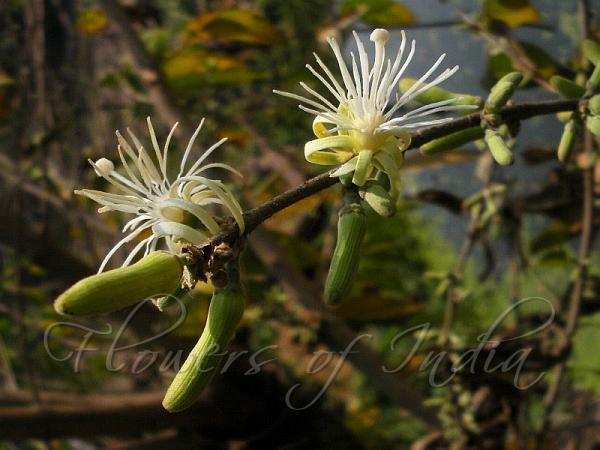|
| Sage Leaved Alangium |
|

|

| File size | 108208 |
| Original date | 3/9/13 10:10 AM |
| Resolution | 800 x 600 |
| Flash | Flash did not fire, auto |
| Focal length | 6.3mm |
| Exposure time | 1/1000s |
| Aperture | 3.5 |
| Focus Distance | |
| Metering Mode | Multi-segment |
| Camera make | NIKON |
| Camera model | COOLPIX S550 |
| Sensor type |
|
|
|
Photo: |
Botanical name: Alangium salviifolium Family: Cornaceae (Dogwood family)
Sage Leaved Alangium is a tall thorny tree native to India. It
grows to a height of about 3 to 10 meters.The bark is ash colored, rough and
faintly fissured. The leaves are elliptic oblong, elliptic lanceolate or
oblong lanceolate, 8-18 x 2.3-7 cm, papery to almost leathery, becoming
hairless, base wedge-shaped, margin entire, tip blunt. Flowers are borne in
stalkless clusters of 4-8 flowers, usually fewer, sometimes only a solitary
flower, densely rusty woolly. Flower-stalks are 2-8 mm. Flowers are fragrant,
cream-colored, 1.2-3 cm. Sepal-cup tube about 2.5 mm; sepals 5-10,
about 3 mm, toothed. Petals are 4-10, basally swollen and at tip blunt,
1.2-3 cm, outside woolly, inside less so, stamens 10-30; filaments 4-12 mm,
at tip geniculate and bearded, style hairless, 8-24 mm, stigma headlike.
Berries are ovoid, ellipsoid or nearly spherical, hairless, smooth
and violet to purple, 9-24 x 6-16 mm. Flowering: February-June.
Medicinal uses: In Ayurveda the roots and the fruits are used for
treatment of rheumatism, and hemorrhoid.Externally it is used for the
treatment of bites of rabbits, rats, and dogs.
In Ayurveda the roots and the fruits are used for
treatment of rheumatism, and hemorrhoid.Externally it is used for the
treatment of bites of rabbits, rats, and dogs.
Medicinal uses:
 In Ayurveda the roots and the fruits are used for
treatment of rheumatism, and hemorrhoid.Externally it is used for the
treatment of bites of rabbits, rats, and dogs.
In Ayurveda the roots and the fruits are used for
treatment of rheumatism, and hemorrhoid.Externally it is used for the
treatment of bites of rabbits, rats, and dogs. | Identification credit: Pravin Kawale | Photographed in Hooghly, WB & Jharkhand. |
• Is this flower misidentified? If yes,